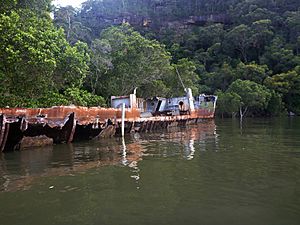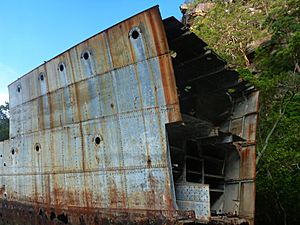HMAS Parramatta Shipwreck and Memorials facts for kids
Quick facts for kids HMAS Parramatta shipwreck and memorials |
|
|---|---|

HMAS Parramatta, Hawkesbury River
|
|
| Location | Cascade Gully, Hawkesbury River, Bar Point, Central Coast, New South Wales, Australia |
| Built | 1909–1910 |
| Architect | Fairfield Shipbuilding & Engineering Ltd |
| Owner | Land and Property Management Authority (LPMA); Parramatta City Council |
| Official name: HMAS Parramatta shipwreck and memorials; HMAS Parramatta (I); HMAS Parramatta (II) | |
| Type | state heritage (built) |
| Designated | 15 December 2006 |
| Reference no. | 1676 |
| Type | Other - Monuments & Memorials |
| Category | Monuments and Memorials |
| Builders | Fairfield Shipbuilding & Engineering at Govan, Scotland |
| Lua error in Module:Location_map at line 420: attempt to index field 'wikibase' (a nil value). | |
The HMAS Parramatta Shipwreck and Memorials are important historical sites in New South Wales, Australia. They include the remains of the first HMAS Parramatta ship, found in the Hawkesbury River. There are also three special memorials connected to this ship and another ship named HMAS Parramatta (II). Two memorials are in Parramatta and one is at Garden Island in Sydney. The first HMAS Parramatta was built in 1910 and became a wreck in 1934. Parts of it were later turned into memorials. The third memorial remembers the second HMAS Parramatta, which was lost during World War II. These sites were added to the New South Wales State Heritage Register in 2006 because of their historical importance.
Contents
A Ship's Story: HMAS Parramatta (I)
Building Australia's First Warship
The wreck of the first HMAS Parramatta (I) is very special. It shows how Australia started its own naval forces. This ship was a torpedo boat destroyer (TBD). It was one of six "River" Class ships built to be fast hunters. These ships were a bit like British "I" Class destroyers. HMAS Parramatta (I) was the first of these Australian ships. It was built in Scotland in 1910. It was also the first to arrive in Australian waters.
The "River" Class ships were about 76 meters long. They weighed 700 tons. They could travel 3,862 kilometers at 15 knots (about 28 km/h). They had one large gun, three smaller guns, and three torpedo tubes. Other sister ships included HMAS Yarra and HMAS Warrego. Some were built in Scotland, and others were built in Sydney.
HMAS Parramatta (I) was ordered in 1909. This was after Australia's different colonial navies joined together. Australia wanted to build a strong navy. The keel of the flagship, HMAS Australia (I), was also laid in 1910. On July 10, 1911, King George V officially started the Royal Australian Navy. HMAS Parramatta (I) was the first ship completed for this new navy.
HMAS Parramatta (I) in World War I
When World War I started in 1914, HMAS Parramatta (I) quickly joined the fight. It served in German New Guinea with the Australian fleet. This fleet included powerful ships like HMAS Australia (I). Their job was to find German warships in the Pacific. The fleet helped land troops in German New Guinea. They captured the important naval base at Rabaul.
HMAS Parramatta (I) was on patrol with the submarine AE1. It was the last ship to see AE1 before the submarine mysteriously sank. This happened on September 14, 1914.
In 1914, Parramatta (I) sailed far up the Sepik River in New Guinea. It was looking for enemy ships. For much of 1915 and 1916, it helped control shipping in the western Pacific. In 1917, the destroyer group went to the Mediterranean Sea. They were based in Brindisi, Italy. Their mission was to hunt for enemy submarines in the Adriatic Sea.
On November 12, 1918, Parramatta (I) was part of the Allied fleet. They entered the Dardanelles after Turkey agreed to stop fighting. After the war, the destroyers went to England. Then they returned to Australia. They were taken out of service between 1919 and 1928.
The Shipwreck and Memorials
HMAS Parramatta (I) ended up in the Hawkesbury River after 1929. It was going to be used as a hulk (an old ship hull). It was sold several times. People used it to store things like blue metal and water. In 1934, a storm pushed Parramatta (I) onto a mud flat. It became a total wreck. Some people even lived on the remains during the Great Depression.
In 1972, the Naval Historical Society of Australia started a project. They wanted to recover the front (bow) and back (stern) parts of the ship. These parts would become memorials. It took a long time to get funding. The stern was finally placed in Queens Wharf Reserve, Parramatta, in 1981. The bow was placed at Garden Island in 1986.
HMAS Parramatta (II): A Wartime Hero
The second HMAS Parramatta (II) was built in Sydney. Its construction started in 1938 and finished in 1940. This ship was 81 meters long and weighed 1,080 tons. HMAS Parramatta (II) served during World War II. It was active in the East Indies and the Mediterranean Sea.
Parramatta (II) was a Grimsby class escort ship. It was sunk by a German U-boat (submarine) on November 27, 1941. This happened in the Mediterranean Sea, near Tobruk, North Africa. Sadly, 138 lives were lost. Only 24 people survived. This was one of the worst losses for the Royal Australian Navy during wartime.
A memorial for Parramatta (II) was built in Queens Wharf Reserve in 1986. It remembers the brave crew who were lost.
What the Sites Look Like
The HMAS Parramatta (I) Shipwreck
The wreck of the first HMAS Parramatta (I) is in shallow water. It's in Cascade Gully in the Hawkesbury River. The bow and stern sections were removed in the 1970s. But the middle part of the ship is still there. You can see parts of the hull (the ship's body) above the water. The metal is very corroded (rusted). Many of the original parts, like portholes, have been removed over the years.
The Parramatta (I) Stern Memorial
The stern (back end) of the first HMAS Parramatta (I) is a memorial. It was cut from the ship using special tools. It was first placed on a brick support. In 2003-2004, it was repaired and restored. Workers fixed rust and damaged parts. The stern was repainted to look like it did during World War I. There are also new plaques inside the memorial.
The Parramatta (I) Bow Memorial
The bow (front end) memorial is at Garden Island Naval base in Sydney. This striking part of the ship is painted naval grey. It sits on a low brick base. This memorial has not been restored recently.
The Parramatta (II) Memorial
The memorial for HMAS Parramatta (II) is also in Queens Wharf Reserve, Parramatta. It's close to the stern memorial. It's a stone block with plaques. There are four white anchors at each corner. A black fence surrounds it. This memorial helps us remember the crew lost in 1941.
Why These Sites Are Important
Why HMAS Parramatta (I) is Special
The HMAS Parramatta (I) shipwreck is very important for New South Wales. It's the only easy-to-reach survivor of the torpedo boat destroyers ordered in 1909. These ships were built for Australia's new navy. The remains of Parramatta (I) show us how warships were built before World War I.
This ship is most important because it was the first completed and commissioned ship of Australia's own navy. This happened in 1910. Parramatta (I) was a "River Class" destroyer. It was the last British design to have an external rudder. Parramatta (I) had a successful military career in World War I. It fought in German New Guinea and served in the Mediterranean and Adriatic Seas. It even visited the famous Gallipoli battlefields.
The wreck site is unique because its parts are in three different places. The bow and stern were removed in 1972 for public display. The main wreck, the stern, and the bow all form part of the heritage listing.
People Connected to HMAS Parramatta
HMAS Parramatta (I) is important because of its link to the Naval Historical Society of Australia. This society started in 1970. Their first project was to recover the bow and stern of Parramatta (I). This project helped the society grow and gain support. Today, the society includes many important naval members.
Famous people have supported the society. Prince Philip opened the bow memorial in 1986. Earl Mountbatten of Burma was given life membership in 1970. Admiral Victor Smith opened the stern memorial in 1982.
The Parramatta (II) memorial is a place for remembrance services. These services honor the 138 crew members lost when the ship was sunk in 1941. Veterans and their families visit this memorial every year. The Royal Australian Navy is also involved. The City of Parramatta has strong historical links to all ships named Parramatta. The loss of Parramatta (II) in 1941 was a major tragedy for the Australian Navy.
Unique Memorials and Design
The bow and stern memorials are special because they use parts of the actual shipwreck. This makes them different from other memorials. They show a unique way to remember people and events. They connect us directly to the ship's history.
Community Connection and Remembrance
The recovery of the ship's parts in 1972 shows how important it was to the community. Volunteers worked hard to make the bow and stern available to the public. These memorials help people learn about the ship and Australia's independent defense. The stern was placed in Parramatta in 1981, and the bow at Garden Island in 1986.
The Parramatta (II) memorial was rededicated in 1986. It is a very important place for the Royal Australian Navy, veterans, and families. It helps them remember the 138 crew members lost in World War II. People have even signed petitions to make sure this memorial is protected on the State Heritage Register. This shows how much the community values these naval heritage sites.
Rare and Important History
The HMAS Parramatta (I) wreck site is rare. It is the most complete and only exposed example of its class of ship. Another ship, HMAS Swan, is underwater and damaged. Only a small part of HMAS Warrego survived.
The bow and stern memorials are also rare in New South Wales. They are some of the only memorials that include actual parts of a historic ship. This makes them very special.
The HMAS Parramatta (I) wreck site is the only accessible ship from the first fleet units ordered for Australia's new navy. It shows the type of small naval attack vessel used by the British Navy. It also shows naval design and construction from just before World War I.
Both Parramatta (I) memorials are examples of naval memorials that use recovered materials. This helps create a real connection to the ship and its history.
Images for kids





